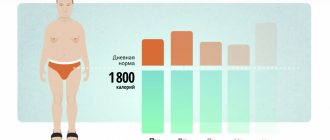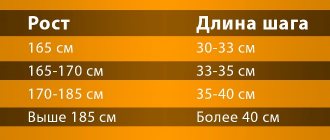Many people, especially those who want to lose weight, count the calories they eat per day, but not everyone knows what they are. Calories are energy that enters the human body with food, especially a lot of it in carbohydrates, as well as fats and proteins. The body processes food, releasing energy, which a person spends on life activities or puts it in “bins” as a reserve.
Calorie content is the energy value of food, how much energy it can provide after its processing. Don’t think that a calorie is an indicator of completeness. Until the beginning of the 20th century, this unit meant the amount of thermal energy. In the modern world, it is used to measure the energy value of food. Next, we will consider the questions of what calories are and how they differ from kilocalories.
What is the difference
Those who monitor body weight and count kcal do not really think about what this means. The reduction in calories is carried out actively, without particularly going into where it came from and where it went.
And most importantly, without thinking about it: calories and kilocalories - what is the difference between them:
- The calorie content of the product is always indicated on the packaging in kilocalories. If it says “N kcal”, you can’t believe it, all products have a calorie content, even the smallest one, and this sign is the ignorance of the manufacturer.
- To be clear, how many calories are in a kilocalorie? 1 kcal = 1000 calories.
- Exercise equipment in the gym often displays incorrect information about the calories burned on it. The measurement is made in kilocalories.
It must be remembered that products with zero or negative kcal do not exist in nature, no matter how their manufacturers claim in their advertisements.
Video
Learn to count calories to lose weight
Experts say that if you eat approximately 3,500 calories, you will add about 450 grams of weight to your existing kilograms. Therefore, in order to lose the same 450 g, it is necessary to create a calorie deficit. You need to reduce your consumption by 3500 calories or increase your energy expenditure by the same amount. You can also combine both methods in order to achieve the desired deficit.
In order to lose weight by about 0.5 kg per week, you need to reduce your daily diet by 500 calories per day. Reducing body weight by 0.5-1 kg is considered systematic and safe for health. It is very important to remember that you should not reduce the number of calories you consume too dramatically. A diet that is too low in calories can cause health problems.
There are many different ways to lose weight and maintain a healthy diet. Tracking calories is just one of them. Controlling portion sizes and choosing nutrient-dense foods are also important. But we believe it's the calories that matter. If you want to learn more about your calorie needs, use the Recommended Daily Calories Calculator or the Recipe Calculator to understand how many calories your favorite foods contain.
Why does the body need kcal?
Energy is required for normal human functioning. To move, breathe, circulate blood through the vessels, and even rest. Energy enters the body from the outside, with food. How much a person eats, so much energy will be generated.
How many kilocalories are contained in one gram of food components:
- carbohydrates – 4 kcal;
- proteins – 4 kcal;
- fats – 9 kcal.
Human food consists of these ingredients. Knowing the weight of the product in a dish, you can easily calculate the calories received from food.
The most popular breakfast is oatmeal. In 100 g there will be so many calories:
- Fat 6 g * 9 kcal = 54 kcal.
- Protein 12 g * 4 kcal = 48 kcal.
- Carbohydrates 51 g * 4 kcal = 204 kcal.
It turns out that 100 g of oatmeal contains 306 kcal. Metabolism will dispose of the received energy as follows: proteins will be converted into amino acids, carbohydrates into glucose and other simple sugars, and fats will be converted into glycerol and fatty acids required by our body.
Video
Where do they go then?
The body processes complex components of foods into simple ones, and then they go:
- Amino acids - from them muscle tissue, some hormones and enzymes are formed.
- Glucose is used to nourish cells. Its excess is deposited in “storage areas”: muscle and liver cells.
- Fats are used as fuel. Some of them go to the liver and are processed into cholesterol. When too much of it is received, it is deposited in the subcutaneous layer. These are exactly the fats that all females and a sufficient number of the stronger sex struggle with.
How is caloric intake distributed if you need to gain weight:
- Proteins – 30% of the total diet.
- Fats – 35% of food.
- Carbohydrates – 45% of the diet.
If you want to lose weight, then the percentage component changes:
- Proteins – 30% of the total products.
- Fats – 20% of products.
- Carbohydrates – 50%.
This is important: The amount of kcal for a person’s daily requirement should be calculated individually. As a result, the amount of proteins, fats and carbohydrates will change significantly.
What is a calorie
Sometimes it can seem like calories are only important to people on a diet. We often hear that they try to eat less or burn more through exercise to lose weight. However, they are of great importance to everyone.
A calorie isn't actually an object, it's a unit of measurement. It measures the amount of energy in food and drink consumed, and all people need this energy to live and stay healthy. Everything a person does is based on energy.
The food consumed becomes the fuel that ensures the functioning of the organs. A healthy diet supplies the body with energy and important nutrients, strengthening bones and muscles. Drinks also contain calories. However, not all of them are useful. Carbonated drinks, for example, are often associated with “empty calories.” This means they have calories that have no nutritional value.
What amount causes excess weight
Calories in food provide necessary energy, but if a person consumes too many of them, he will gain weight. The excess is stored as fat. The body needs some fat reserves to stay healthy, but too much fat can lead to problems.
It is important to understand your calorie needs. That is, to know the amount that the body needs to perform basic metabolic functions and daily physical activity. This need can be calculated using simple formulas and online calculators.
The daily recommended intake for the average person can range from 1,000 to 2,000 calories per day. But this number is a general estimate and may change depending on a number of factors. Men can eat a little more, women should eat less because their bodies are smaller, which means they need less energy.
Individual calorie needs depend on several factors, such as activity level and metabolism.
Calories in food
Different types of food have different energy levels. That is, the three macronutrients are not all equal in the number of calories they provide. Each gram of protein and carbohydrates provides 4 calories, and each gram of fat provides 9.
Because fat contains more calories per gram, many dieters and healthy eaters try to limit the amount of fat in their diet. However, some types of fats are essential for a healthy body. Polyunsaturated fats, for example, can help maintain a healthy heart.
And while carbohydrates provide fewer calories, some are not as healthy as others. Refined carbohydrates, for example, are considered empty calories.
To lose weight, a person must consume less and burn more.
However, some calories provide specific weight loss benefits. For example - from protein - they are useful in building and maintaining muscle mass. When a person has more muscle, they will be able to stay active longer during the day and burn more calories. Calories from fiber-rich foods will help you feel full throughout the day, allowing you to eat less and lose weight.
How to calculate the calorie content of foods
Quite often, young girls try to lose weight by reducing calories. At the same time, they maintain their usual diet, just monitor the balance.
Video
The important principles in this method of losing weight remain:
- The amount of kilocalories eaten per day should be equal to or less than the amount of energy consumed during the day.
- It does not matter what products are used. It is important not to overstep the target limit and not to eat too much.
- You cannot significantly reduce the daily kcal norm so as not to provoke a malfunction of the systems and not get any diseases.
The calorie content of foods is calculated as shown in the example of oatmeal:
- Ingredients for preparing porridge: 200 g of cereal, a liter of milk, 2 tablespoons of sand, a pinch of salt, a spoon of cow butter.
- Calorie content: cereal – 732 kcal, milk – 640 kcal, sand – 199 kcal, butter – 149.6 kcal, salt – 0 kcal.
- The final result of the resulting porridge is 1720.6 kcal.
The numerical index of the calorie content of a product is available in a table that can be found on the Internet or in specialized literature.
When calculating, you need to take into account some nuances:
- The indicator for boiled cereals and pasta is three times less than the same product in its raw form.
- The weight of boiled meat decreases quite significantly, but rice, on the contrary, becomes larger.
- Dried foods (fruits, mushrooms, berries and crackers) have a much higher calorie content than the same foods in their original form. Here you need to calculate in this way: first, calculate the indicator x - the difference in the weight of the dried product, and then multiply the indicator from the table by x.
- In soup, you need to calculate not only those products that are included in the broth, but also seasonings, sour cream and everything that is usually added directly to the plate.
Nutrition must be monitored carefully, taking maximum care to ensure that healthy foods enter the body.
Calories in food
Different types of food provide different levels of energy. More precisely, the three groups of macronutrients differ in the number of calories they contain. So, every gram of protein or carbohydrates provides 4 calories, while for every gram of fat there are 9 calories.
Due to the higher calorie content of fat, many adherents of healthy eating and diets try to limit the amount of fat in their diet. But some types of fats are simply necessary for the health of the body. For example, polyunsaturated fat supports heart health. But although carbohydrates contain fewer calories than fats, some of them are not so healthy. Refined carbohydrates, for example, contain empty calories.
But when it comes to weight loss, are all calories the same? In general, experts agree that a calorie is always a calorie. And it doesn’t matter where it comes from. And, in order to lose weight, you need to burn more calories and consume less.
However, some calories have specific weight loss benefits. For example, those that enter the body from proteins help in building and maintaining muscles. With more muscle, it's easier to stay active throughout the day and burn more calories. Or calories from fiber-rich foods, which help you feel full and satisfied with what you eat throughout the day, making you eat less and become slimmer.
How to calculate your daily caloric intake
To determine calorie content, you need to take into account some indicators:
- Metabolism (OM). It is affected by work schedule, physical activity, and nutrition. OB is calculated as follows: weight multiplied by 20 kcal.
- Age. How to calculate: for every 10 years after age 20, reduce by 2%.
- Floor. Typically, males require more calories.
- Rhythm of life. The percentage of activity is calculated: inactive - 20%, sedentary with little activity (going to the store, cleaning, walking, etc.) - 30%, average - 40%, high (sports, physical work) - 50%.
- Physical activity (PA) is calculated as follows: OB needs to be multiplied by the percentage of the rhythm of life.
- Percentage of energy during food digestion (PEPP). It is determined as follows: (FA is summed with OB) and multiplied by 10%.
Video
The daily intake of kcal is equal to – PEPP + FA + OB. The final indicator must be adjusted to your age; this is to subtract 2% from the result for the 10 years after the 20-year mark. If the total consumption rate is calculated for weight loss, then the result should be clarified: the daily calorie rate from which is subtracted (weight multiplied by 7 kcal).
Please note: It is necessary to take into account the energy needs of each person individually. Children and adults will have different meanings. Athletes and pregnant women should increase their calorie intake.
Low and high calorie foods
Which foods have many or few calories? This is affected by the chemical content. The lowest calorie foods are those whose energy value is less than 40 kcal per 100 g.
Which foods are low in calories:
- Vegetable products: cucumbers, lettuce, greens, garlic, sweet peppers, any onions, beets.
- Fruits and berries: citrus fruits, blackberries, strawberries, quince, cherries, pineapple, cherry plum, lingonberries, kiwi, apple, pomegranates and raspberries.
- Meat products: chicken, rabbit, lean beef, kidneys.
- Fish products: pollock, hake, blue whiting, flounder, shrimp, smelt and other types of river fish.
- Dairy products: all, only low fat.
- From sweets: marshmallows and marshmallows, marmalade.
- From flour - rye bread.
Those foods that have a high calorie content are those that have from 500 to 900 kcal per 100 g. Eating them is unsafe for your figure.
Video
These products include:
- Any types of oils.
- Pork is fatty, lard.
- Raw smoked sausages.
- Cakes with cream.
- Nuts of any kind.
- Milk chocolate.
High-calorie foods include alcoholic drinks, and they also cause increased appetite.
Expert opinion
Smirnov Viktor Petrovich Dietitian, Samara
Many healthy eating enthusiasts do not know what calories are. How much energy does a person spend per day? Let's give a simple example. The article provides a table of a one-day menu for a person with a light level of physical activity. It is approximately 2500 kilocalories per day. As you know, one calorie heats 1 gram, or 1 ml, of water by 1 degree. What can 2500 kilocalories, or 2.5 million calories, do? First of all, such an amount of energy, however, purely theoretically, will allow heating 1 gram of water by 2.5 million degrees, and this is the temperature of thermonuclear fusion, which occurs in the depths of the sun and is the source of all the energy received by the Earth.
And here is the second example, more “down to earth”. Two large household buckets occupy a total volume of 24 liters (12 liters each). What can the same daily flow do to this volume of water? Simple calculation: (2500000/24000 ml). As a result, the balance is 104. Thus, the amount of energy consumed per day by a person at a “sedentary” job can boil two full buckets of water. Therefore, a person on a low-calorie diet and trying to lose weight should not complain that he receives very little energy. It is enough to remember these numbers, and it will immediately feel easier for him.
The concept of calorie and kilocalorie
When dieters or ordinary consumers use the word "calories" in relation to nutrition, they usually mean it informally.
They are actually talking about kilocalories, which are listed on food labels. What is the difference between these two concepts:
The definition of calorie (cal), or small calorie, is the amount of heat required to raise the temperature of one gram of water by one degree Celsius.
A kilocalorie (kcal), or large calorie, is the amount of heat required to raise the temperature of one kilogram of water by one degree Celsius. It is equivalent to 1000 small ones. Kilocalories, in relation to the energy in food, are sometimes called "food" or simply shortened to "calories".
Another unit of measurement used to quantify energy is called the joule. One small is equivalent to just under 4.2 joules. A kilocalorie (kcal) is equal to approximately 4.2 kilojoules.










